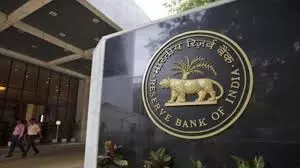India to grow 7% in FY 25 says RBI Annual Report

Reserve Bank of India (RBI) (Image: DC)
Mumbai: India’s economy is likely to grow at 7 per cent for 2024-25 with risks evenly balanced, the Reserve Bank of India (RBI) said in its Annual Report 2023-24 released on Thursday. The central bank said that the outlook for the Indian economy in 2024-25 is brightening underpinned by a sustained strengthening of macroeconomic fundamentals, robust financial and corporate sectors and a resilient external sector.” The government’s continued thrust on capex while pursuing fiscal consolidation, and consumer and business optimism augur well for investment and consumption demand. It however sees food inflation remaining vulnerable to recurring supply shocks which are preventing a quicker alignment of headline inflation with the target.
The Indian economy, it said, expanded at a robust pace in 2023-24 (April 2023 to March 2024 financial year), with real GDP growth accelerating to 7.6 per cent from 7.0 per cent in the previous year – the third successive year of 7 per cent or above growth.
The RBI stated that the implementation of digital tax systems has improved tax collections, and the Centre aims to achieve direct tax revenues of 6.7 per cent of GDP in 2024-25, the highest in thirty years.
As headline inflation eases towards the target, it will spur consumption demand especially in rural areas. The external sector’s strength and buffers in the form of foreign exchange reserves will
insulate domestic economic activity from global spillovers. “Geopolitical tensions, geo-economic fragmentation, global financial market volatility, international commodity price movements and erratic weather developments pose downside risks to the growth outlook and upside risks to the inflation outlook.”
“The Indian economy would also have to navigate the medium-term challenges posed by rapid adoption of AI/ML technologies and recurrent climate shocks,” said the report.
The central bank said that the unemployment rate fell to its lowest level during 2023 (January-December) - 3.1 per cent in the usual status with both urban and rural areas recording a decline.
The labour force participation rate (LFPR) and worker population ratio (usual status) were 59.8 per cent and 58.0 per cent, respectively, the highest since the survey’s inception in 2017-18. Meanwhile the RBI’s balance sheet size rose 11.08 per cent to Rs 70.48 lakh crore as of March 31, 2024, the Annual Report showed. The central bank's balance sheet size at $844.76 is nearly 2.5 times that of Pakistan's entire GDP which has been estimated to be around $338.24 billion by the International Monetary Fund (IMF).
( Source : Deccan Chronicle )
Next Story

